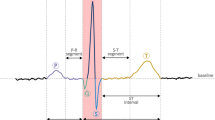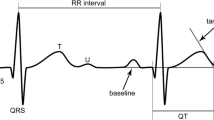Abstract
Identification and classification of ventricular arrhythmias such as rhythmic ventricular tachycardia (VT) and disorganized ventricular fibrillation (VF) are vital tasks in guiding implantable devices to deliver appropriate therapy in preventing sudden cardiac deaths. Recent studies have shown VF can exhibit strong regional organizations, which makes the overlap zone between the fast paced rhythmic VT and VF even more ambiguous. Considering that implantable cardioverter-defibrillator (ICD) are primarily rate dependent detectors of arrhythmias and that there may be patients who suffer from arrhythmias that fall in the overlap zone, it is essential to identify the degree of affinity of the arrhythmia toward VT or organized/disorganized VF. The method proposed in this work better categorizes the overlap zone using Wavelet analysis of surface ECGs. Sixty-three surface ECG signal segments from the MIT-BIH database were used to classify between VT, organized VF (OVF), and disorganized VF (DVF). A two-level binary classifier was used to first extract VT with an overall accuracy of 93.7 % and then the separation between OVF and DVF with an accuracy of 80.0 %. The proposed approach could assist clinicians to provide optimal therapeutic solutions for patients in the overlap zone of VT and VF.





Similar content being viewed by others
References
Abdullah Arafat M, Sieed J, Kamrul Hasan M (2009) Detection of ventricular fibrillation using empirical mode decomposition and bayes decision theory. Comput Biol Med 39(11):1051–1057
Addison P (2005) Wavelet transforms and the ecg: a review. Physiol Meas 26:R155
Akritas A, Malaschonok G, Vigklas P (2006) The svd-fundamental theorem of linear algebra. Nonlinear Anal 11(2):123–136
Angrisani L, Daponte P, D’Apuzzo M, Testa A (1998) Ameasurement method based on the wavelet transform for power quality analysis. IEEE Trans Power Del 13(4):990–998
Asl B, Setarehdan S, Mohebbi M (2008) Support vector machine-based arrhythmia classification using reduced features of heart rate variability signal. Artif Intell Med 44(1):51–64
Balasundaram K, Masse S, Nair K, Farid T, Nanthakumar K, Umapathy K (2011) Wavelet-based features for characterizing ventricular arrhythmias in optimizing treatment options. In: Engineering in Medicine and Biology Society, 2011. IEMBS’11. 33rd Annual international conference of the IEEE, vol 1. IEEE, New York, pp 969–972
Barquero-Pe′rez O′, Rojo-Alvarez J, Caaman˜ o A, Goya-Esteban R, Everss E, Alonso-Atienza F, Sa′nchez-Munoz J, Garc′ıa-Alberola A (2010) Fundamental frequency and regularity of cardiac electrograms with fourier organization analysis. Biomed Eng IEEE Trans 57(9):2168–2177
Casey M (1998) Auditory group theory with applications to statistical basis methods for structured audio. Ph.D. thesis, Massachusetts Institute of Technology
Cheng K, Dosdall D, Li L, Rogers J, Ideker R, Huang J (2012) Evolution of activation patterns during long-duration ventricular fibrillation in pigs. Am J Physiol Heart Circ Physiol 302(4):H992–H1002
Ciaccio E, Coromilas J, Wit A, Garan H (2011) Onset dynamics of ventricular tachyarrhythmias as measured by dominant frequency. Heart Rhythm 8(4):615–623
Clayton R, Murray A, Campbell R (1994) Changes in the surface electrocardiogram during the onset of spontaneous ventricular fibrillation in man. Eur Heart J 15(2):184
Foomany FH, Umapathy K, Krishnan S, Masse S, Farid T, Nair K, Dorian P, Nanthakumar K (2010) Wavelet-based markers of ventricular fibrillation in optimizing human cardiac resuscitation. In: Conference proceedings: IEEE Engineering in Medicine and Biology Society, pp 2001–2004
Fukunaga K (1990) Introduction to statistical pattern recognition. Academic Press, New York
Fukuoka Y, Oostendorp T, Armoundas A (2009) Method for guiding the ablation catheter to the ablation site: a simulation and experimental study. Med Biol Eng Comput 47(3):267–278
Goldberger AL, Amaral LAN, Glass L, Hausdorff JM, Ivanov PC, Mark RG, Mietus JE, Moody GB, Peng CK, Stanley HE (2000) PhysioBank, PhysioToolkit, and PhysioNet: components of a new research resource for complex physiologic signals. Circulation 101(23):e215–e220. http://circ.ahajournals.org/cgi/content/full/101/23/e215
Hassanpour H, Mesbah M, Boashash B (2004) Time-frequency feature extraction of newborn eeg seizure using svd-based techniques. EURASIP J Appl Signal Process 2004:2544–2554
Huang J, Rogers J, Killingsworth C, Singh K, Smith W, Ideker R (2004) Evolution of activation patterns during long-duration ventricular fibrillation in dogs. Am J Physiol Heart Circul Physiol 286(3):H1193
Khadra L, Al-Fahoum A, Al-Nashash H (1997) Detection of life-threatening cardiac arrhythmias using the wavelet transformation. Med Biol Eng Comput 35(6):626–632
Krasteva V, Jekova I (2005) Assessment of ecg frequency and morphology parameters for automatic classification of life-threatening cardiac arrhythmias. Physiol Meas 26:707
Lerma C, Wessel N, Schirdewan A, Kurths J, Glass L (2008) Ventricular arrhythmias and changes in heart rate preceding ventricular tachycardia in patients with an implantable cardioverter defibrillator. Med Biol Eng Comput 46(7):715–727
Li H, Han W, Hu C, Meng M (2009) Detecting ventricular fibrillation by fast algorithm of dynamic sample entropy. In: Robotics and Biomimetics (ROBIO), 2009 IEEE International Conference. IEEE, New York, pp 1105–1110
Mallat S (1999) A wavelet tour of signal processing. Academic Press, New York
Masse’ S, Downar E, Chauhan V, Sevaptsidis E, Nanthakumar K (2007) Ventricular fibrillation in myopathic human hearts: mechanistic insights from in vivo global endocardial and epicardial mapping. Am J Physiol Heart Circ Physiol 292(6):H2589
Mishkin J, Saxonhouse S, Woo G, Burkart T, Miles W, Conti J, Schofield R, Sears S, Aranda J Jr (2009) Appropriate evaluation and treatment of heart failure patients after implantable cardioverter-defibrillator discharge: time to go beyond the initial shock. J Am Coll Cardiol 54(22):1993–2000
Namarvar H, Shahidi A (2004) Cardiac arrhythmias predictive detection methods with wavelet-svd analysis and support vector machines. In: Engineering in Medicine and Biology Society, 2004. IEMBS’04. 26th Annual international conference of the IEEE, vol 1. IEEE, New York, pp 365–368
Nanthakumar K, Walcott G, Melnick S, Rogers J, Kay M, Smith W, Ideker R, Holman W (2004) Epicardial organization of human ventricular fibrillation. Heart Rhythm 1(1):14–23
Narayan SM, Krummen DE, Shivkumar K, Clopton P, Rappel WJ, Miller JM (2012) Treatment of atrial fibrillation by the ablation of localized sources. J Am Coll Cardiol 60(7):628–636
Omar M, Solouma N, Kadah Y (2006) Morphological characterization of ecg signal abnormalities: a new approach. In: Proceedings of Cairo international biomedical engineering conference, pp 1–5
Ozkurt N, Savaci F (2005) Determination of wavelet ridges of nonstationary signals by singular value decomposition. Circuits Syst II Express Briefs IEEE Trans 52(8):480–485. doi:10.1109/TCSII.2005.849041
Potse M, Essebag V (2009) Guidance for catheter ablation of ventricular arrhythmia. Med Biol Eng Comput 47(3):241–243
Povinelli RJ, Roberts FM, Ropella KM, Johnson MT (2002) Are nonlinear ventricular arrhythmia characteristics lost, as signal duration decreases? In: Proceedings. Computers in Cardiology, Memphis, TN, pp 221–224
Roberts F, Povinelli R, Ropella K (2001) Identification of ecg arrhythmias using phase space reconstruction. Principles of data mining and knowledge discovery, pp 411–423
Rocha T, Paredes S, de Carvalho P, Henriques J, Antunes M (2008) Phase space reconstruction approach for ventricular arrhythmias characterization. In: Engineering in Medicine and Biology Society, 2008. EMBS 2008. 30th Annual international conference of the IEEE. IEEE, New York, pp 5470–5473
Ropella K, Baerman J, Sahakian A, Swiryn S (1990) Differentiation of ventricular tachyarrhythmias. Circulation 82(6):2035–2043
Samie F, Berenfeld O, Anumonwo J, Mironov S, Udassi S, Beaumont J, Taffet S, Pertsov A, Jalife J (2001) Rectification of the background potassium current: a determinant of rotor dynamics in ventricular fibrillation. Circ Res 89(12):1216
Samie F, Jalife J (2001) Mechanisms underlying ventricular tachycardia and its transition to ventricular fibrillation in the structurally normal heart. Cardiovasc Res 50(2):242
Sierra G, de Jesu’s Go’mez M, Le Guyader P, Trelles F, Cardinal R, Savard P, Nadeau R (1998) Discrimination between monomorphic and polymorphic ventricular tachycardia using cycle length variability measured by wavelet transform analysis. J Electrocardiol 31(3):245–255
SPSS Inc (1990) SPSS advanced statistics user’s guide. In: User manual, SPSS Inc., Chicago, IL
Strang G (2003) Introduction to linear algebra. Wellesley Cambridge Press, Wellesley
Strohmenger H, Lindner K, Brown C (1997) Analysis of the ventricular fibrillation ECG signal amplitude and frequency parameters as predictors of countershock success in humans. Chest 111(3):584
Ten Tusscher K, Mourad A, Nash M, Clayton R, Bradley C, Paterson D, Hren R, Hayward M, Panfilov A, Taggart P (2009) Organization of ventricular fibrillation in the human heart: experiments and models. Exp Physiol 94(5):553
Thomas S, Thiagalingam A, Wallace E, Kovoor P, Ross D (2005) Organization of myocardial activation during ventricular fibrillation after myocardial infarction. Circulation 112(2):157–163
Tsipouras M, Fotiadis D, Sideris D (2002) Arrhythmia classification using the RR-interval duration signal. In: Computers in cardiology. IEEE, New York, pp 485–488
Umapathy K, Krishnan S, Masse S, Hu X, Dorian P, Nanthakumar K (2009) Optimizing cardiac resuscitation outcomes using wavelet analysis. In: International conference of the IEEE engineering in medicine and biology society, vol 1, pp 6761–6764
Venkatachalam V, Aravena J (1999) Nonstationary signal classification using pseudo power signatures: the matrix svd approach. Circuits and systems II: analog and digital signal processing. IEEE Trans 46(12):1497–1505. doi:10.1109/82.809535
Wall M, Rechtsteiner A, Rocha L (2003) Singular value decomposition and principal component analysis. In: A practical approach to microarray data analysis, pp 91–109
Wathen M, DeGroot P, Sweeney M, Stark A, Otterness M, Adkisson W, Canby R, Khalighi K, Machado C, Rubenstein D et al (2004) Prospective randomized multicenter trial of empirical antitachycardia pacing versus shocks for spontaneous rapid ventricular tachycardia in patients with implantable cardioverter-defibrillators. Circulation 110(17):2591–2596
Wathen M, Sweeney M, DeGroot P, Stark A, Koehler J, Chisner M, Machado C, Adkisson W (2001) Shock reduction using antitachycardia pacing for spontaneous rapid ventricular tachycardia in patients with coronary artery disease. Circulation 104(7):796–801
Watson J, Addison P, Clegg G, Holzer M, Sterz F, Robertson C (2000) A novel wavelet transform based analysis reveals hidden structure in ventricular fibrillation. Resuscitation 43(2):121–127
Wilkoff B, Kuhlkamp V, Volosin K, Ellenbogen K, Waldecker B, Kacet S, Gillberg J, DeSouza C (2001) Critical analysis of dual-chamber implantable cardioverter-defibrillator arrhythmia detection: results and technical considerations. Circulation 103(3):381
Acknowledgments
The authors would like to thank the Hull family cardiac fibrillation management laboratory, Toronto General Hospital, and in particular Dr K. Nanthakumar for his expert opinion on this work. The authors also thankfully acknowledge Natural Sciences & Engineering Research Council of Canada (Grant to Dr. K. Umapathy) for supporting this work.
Author information
Authors and Affiliations
Corresponding author
Rights and permissions
About this article
Cite this article
Balasundaram, K., Masse, S., Nair, K. et al. A classification scheme for ventricular arrhythmias using wavelets analysis. Med Biol Eng Comput 51, 153–164 (2013). https://doi.org/10.1007/s11517-012-0980-y
Received:
Accepted:
Published:
Issue Date:
DOI: https://doi.org/10.1007/s11517-012-0980-y




